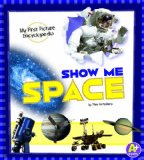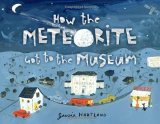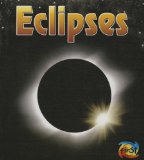What is more inspiring than space?
If you are doing a science theme about space or the solar system and are looking for books for children, you’ve come to the right place. (Note: Linked titles go to Amazon for more information. Please see the disclaimer below). The titles are organized by reading level.
Looking for more specific information? Visit our more recent, specialized lists about:
- Moon and Lunar Landings
- Planets and Solar Systems
- Stars and Galaxies
Nonfiction
Beginning Readers- Informational Texts
Space (Smithsonian Little Explorer) by Martha E. H. Rustad is a quick introduction to topics ranging from the moon and planets to the Big Bang. Colorful photographs and eye-catching illustrations help keep interest and put things in perspective. See how many Earths placed on top of each other would equal the height of the sun. Fascinating!
Reading Level grades 1-2
Publisher: Capstone Press (November 1, 2013)
ISBN-10: 1476535515
ISBN-13: 978-1476535517
Comets (Heinemann First Library: the Night Sky and Other Amazing Sights in Space) by Nick Hunter explains how these bits of dust and ice orbit the sun in our solar system. Starting with ancient records of comets, Hunter describes some of the most famous comets and how they were discovered, He concludes with an activity using balls and a playing field to help children conceptualize the vastness of space.
Reading Level: Grades 1-3
Publisher: Heinemann (August 1, 2013)
ISBN-10: 1432975196
ISBN-13: 978-1432975197

Show Me Space: My First Picture Encyclopedia (My First Picture Encyclopedias) by Steve Kortenkamp is a visually-stimulating way to learn about our sun, the planets, moons and even far away galaxies.
Reading level: 1-2
Ages 4-8
Series: My First Picture Encyclopedias
Publisher: Capstone Press (February 1, 2013)
ISBN-10: 1620659220
ISBN-13: 978-1620659229
Stars and Constellations (Heinemann First Library: The Night Sky: And Other Amazing Sights in Space) by Nick Hunter explores what stars are, where they come from, what makes them shine, what people thought of them in the past, and how we study stars today, starting with the nearest star, the Sun. A fun activity is provided along with advice on viewing stars.
Reading Level: Grades 1-3
Publisher: Heinemann (August 1, 2013)
Language: English
ISBN-10: 143297517X
ISBN-13: 978-1432975173
Eclipses (Heinemann First Library: The Night Sky: And Other Amazing Sights in Space) by Nick Hunter (Author) examines both solar and lunar eclipses, as well as eclipses on other planets. The book covers what an eclipse is, what eclipses can look like, how they happen, what people thought of eclipses in the past, and how they are studied today. He concludes with an activity, along with advice on viewing eclipses.
Reading Level: Grades 1-3
Publisher: Heinemann (August 1, 2013)
ISBN-10: 1432975153
ISBN-13: 978-1432975159
Northern Lights (Heinemann First Library) by Nick Hunter covers some of the coolest phenomena we can see without a telescope: the Aurora Borealis or Northern Lights. He explains what they are, what they look like, where they can be seen, and how they are caused. Readers also learn about the significance of solar storms, the Southern Lights, what people thought about auroras in the past, and how they are explored today. As with the others in this series, he concludes with a fun activity.
Reading level: Grades 1-3
Publisher: Heinemann (August 1, 2013)
Language: English
ISBN-10: 1432975161
ISBN-13: 978-1432975166
Picture Books
If You Were the Moon by Laura Purdie Salas and illustrated by Jaime Kim
Combining spare, imaginative text with denser scientific explanations, this book has potential for a multitude of uses. It can be a lovely bedtime book, the basis for a language arts lesson, or a great accompaniment to a lesson on the solar system.
Salas must inspire her illustrators to greatness, because Jaime Kim’s art positively shines.
If You Were the Moon is a must have for budding astronomers and poets everywhere.
Visit Laurie Purdie Salas’s website for downloadable teaching guides (long and short versions) and other goodies.
Age Range: 4 – 8 years
Publisher: Millbrook Press (March 1, 2017)
ISBN-10: 146778009X
ISBN-13: 978-1467780094

How the Meteorite Got to the Museum by Jessie Hartland
In her usual lightly humorous style Hartland reveals how a piece of the Peekskill meteorite ended up on display at the American Museum of Natural History. This book is the third in a series in which Hartland uses a cumulative story technique borrowed from “The House that Jack Built.” Here she explains where the meteorite came from, who saw it, and what the owner of the car did when she discovered the damage, etc.
Reviewed at Wrapped in Foil
Age Range: 6 – 9 years
Grade Level: 1 – 4
Hardcover: 40 pages
Publisher: Blue Apple Books (October 8, 2013)
ISBN-10: 1609052528
ISBN-13: 978-1609052522
Picture Books about the Planets/Solar System:
Pluto’s Secret: An Icy World’s Tale of Discovery by Margaret Weitekamp and David DeVorkin, illustrated by Diane Kidd
With the the change in 2006 from having nine planets in the solar system to only eight, children may be wondering what happened to Pluto. Why isn’t it a planet any longer? Pluto’s Secret: An Icy World’s Tale of Discovery by Margaret Weitekamp, with David DeVorkin, and illustrated by Diane Kidd uses a whimsical approach to explain the discovery of Pluto, its history and how scientific classifications change as we uncover more information about the world around us.
Reviewed at Growing with Science
Age Range: 5 – 9 years
Grade Level: Kindergarten – 4
Publisher: Harry N. Abrams (March 12, 2013)
ISBN-10: 1419704230
ISBN-13: 978-1419704239
13 Planets: The Latest View of the Solar System
by David A. Aguilar
Explains the most recent view (2011) of the planets in our solar system, with eight planets in the classical sense and five dwarf planets.
Age Range: 8 – 12 years
Publisher: National Geographic Children’s Books (March 8, 2011)
ISBN-10: 1426307705
ISBN-13: 978-1426307706
National Geographic Kids First Big Book of Space by Catherine D. Hughes and illustrated by David A. Aguilar
At 128 pages, this is a big book! Even though it exceeds the usual length, let’s keep it in the picture book section because of the fabulous illustrations and the reading age level.
Age Range: 4 – 8 years
Publisher: National Geographic Children’s Books (October 9, 2012)
ISBN-10: 1426310145
ISBN-13: 978-1426310140
Picture books About the Lunar Landing:
Footprints on the Moon by Alexandra Siy
Illustrated with photographs, this book documents
Age Range: 3 – 7 years
Publisher: Charlesbridge (February 1, 2001)
ISBN-10: 1570914095
ISBN-13: 978-1570914096
Moonshot: The Flight of Apollo 11 by Brian Floca is an extraordinary book. You can tell the minute you open it and see the front endpapers, which have exquisite, detailed illustrations of Apollo 11.
Age Range: 4 – 10 years
Series: Richard Jackson Books (Atheneum Hardcover)
Publisher: Atheneum/Richard Jackson Books (April 7, 2009)
ISBN-10: 141695046X
ISBN-13: 978-1416950462
One Giant Leap
by Robert Burleigh and illustrated by Mike Wimmer
Another book to commemorate the 40th anniversary lunar landing, it is also well done.
Age Range: 6 – 8 years
Publisher: Philomel (April 2, 2009)
ISBN-10: 0399238832
ISBN-13: 978-0399238833
Look to the Stars by Buzz Aldrin and illustrated by Wendell Minor is remarkable because it is much more than merely an account by the second human being to touch the surface of the moon. Dr. Aldrin shows us how this incredible accomplishment is part of a long history of discoveries and advancements, and how it may lead to many more new things in the future.
Full review at Wrapped in Foil
Age Range: 6 – 8 years
Grade Level: 1 – 3
Hardcover: 40 pages
Publisher: Putnam Juvenile (May 14, 2009)
Language: English
ISBN-10: 0399247211
ISBN-13: 978-0399247217
Let’s-Read-and-Find-Out Science 2 has a whole series of titles about space and space exploration:
Floating in Space (Let’s-Read-and-Find-Out Science 2) by Franklyn M. Branley and illustrated by True Kelley
Age Range: 4 – 8 years
Publisher: HarperCollins (January 3, 1998)
ISBN-10: 0064451429
ISBN-13: 978-0064451420
The International Space Station (Let’s-Read-and-Find-Out Science 2)
by Franklyn M. Branley and illustrated by True Kelley
Age Range: 4 – 8 years
Publisher: HarperCollins (September 19, 2000)
ISBN-10: 0064452093
ISBN-13: 978-0064452090
The Sky Is Full of Stars (Let’s-Read-and-Find-Out Science 2)
by Franklyn M. Branley and illustrated by Felicia Bond
This title is about the constellations you can see in the night sky. Because it is illustrated by Felicia Bond (Give a Mouse a Cookie), it has a different look than some of the others that come later in the series.
Age Range: 4 – 8 years
Publisher: HarperCollins; 1 edition (March 9, 1983)
ISBN-10: 0064450023
ISBN-13: 978-0064450027
The Moon Seems to Change (Let’s-Read-and-Find-Out Science 2)
by Franklyn M. Branley and illustrated by Barbara & Ed Emberley
Age Range: 4 – 8 years
Publisher: HarperCollins; Revised edition (July 24, 1987)
ISBN-10: 0064450651
ISBN-13: 978-0064450652
The Big Dipper (Let’s-Read-and-Find-Out Science 1)
by Franklyn M. Branley and illustrated by Molly Coxe
Age Range: 4 – 8 years
Publisher: HarperCollins; Revised edition (April 15, 1991)
ISBN-10: 0064451003
ISBN-13: 978-0064451000
What the Moon is Like (Let’s-Read-and-Find-Out Science, Stage 2) by Franklyn M. Branley and illustrated by True Kelley
Age Range: 4 – 8 years
Publisher: HarperCollins; Ill edition (May 3, 2000)
ISBN-10: 0064451852
ISBN-13: 978-0064451857
Mission to Mars (Let’s-Read-and-Find-Out Science 2)
by Franklyn M. Branley and illustrated by True Kelley
Explores the premise that someday people may visit, and even live on, Mars.
Age Range: 4 – 8 years
Publisher: HarperCollins (September 3, 2002)
ISBN-10: 0064452336
ISBN-13: 978-0064452335
Middle Grade
Space, Stars, and the Beginning of Time: What the Hubble Telescope Saw by Elaine Scott
A history of the Hubble Telescope and overview of how the images it has captured have added to the field of astronomy. Although written for middle grades, it is also useful for adults wishing to brush up on the topic.
Age Range: 9 – 12 years
Grade Level: 4 – 7
Publisher: Clarion Books (January 24, 2011)
ISBN-10: 0547241895
ISBN-13: 978-0547241890
The Mighty Mars Rovers: The Incredible Adventures of Spirit and Opportunity (Scientists in the Field Series)
by Elizabeth Rusch
Age Range: 10 and up
Grade Level: 5 – 9
Lexile Measure: 950L (What’s this?)
Series: Scientists in the Field Series
Hardcover: 80 pages
Publisher: HMH Books for Young Readers (June 19, 2012)
Language: English
ISBN-10: 054747881X
ISBN-13: 978-0547478814
Cars on Mars: Roving the Red Planet
by Alexandra Siy
Age Range: 8 – 12 years
Publisher: Charlesbridge; New edition (July 1, 2009)
ISBN-10: 1570914621
ISBN-13: 978-1570914621
Planet Hunter: Geoff Marcy and the Search for Other Earths
by Vicki Oransky Wittenstein
Have you ever wanted to visit the laboratory of a ground-breaking research scientist? Now you can, because Planet Hunter: Geoff Marcy and the Search for Other Earths by Vicki Oransky Wittenstein will allow you to feel like you are standing right next to Dr. Geoff Marcy in his quest to find extrasolar planets (planets that revolve around stars other than our sun).
Full review at Wrapped in Foil
Related activities at Growing with Science
Age Range: 10 – 14 years
Publisher: Boyds Mills Press (March 1, 2010)
ISBN-10: 1590785924
ISBN-13: 978-1590785928
Is There Life on Other Planets?: And Other Questions About Space (Is That a Fact?)
by Gregory L. Vogt and illustrated by Colin W. Thompson
Another in the Is That a Fact? series, this one investigates some silly myths as well as serious, such as, “Is the moon made of green cheese? and “Do astronauts wear diapers?”
Reading level: Ages 9-12
Library Binding: 40 pages
Publisher: Lerner Publications (March 2010)
ISBN-10: 0822590824
ISBN-13: 978-0822590828
Spacecraft (Machines Close-Up) by Daniel Gilpin and illustrated by Alex Pang
Full color cut-away illustrations show the ins and outs of space vehicles past, present and future.
Reading level: Ages 9-12
Publisher: Benchmark Books; 1 edition (September 2010)
ISBN-10: 1608701123
ISBN-13: 978-1608701124
A Black Hole Is Not a Hole
by Carolyn Cinami DeCristofano
Age Range: 9 – 12 years
Publisher: Charlesbridge (February 1, 2012)
ISBN-10: 1570917833
ISBN-13: 978-1570917837
Young Adult
Earthrise: My Adventures as an Apollo 14 Astronaut by Edgar Mitchell, Ellen Mahoney, and with a foreword by Dr. Brian Cox
Fast-paced autobiography of Dr. Edgar Mitchell, who went to the moon in 1971 on Apollo 14. Although obviously a must-have resource for future astronauts, Earthrise is also likely to appeal to those interested in history, science, engineering, and aviation. It is a revealing look at how one man’s sense of adventure took him places that the rest of us can only imagine.
Full review at Growing with Science.
Age Range: 12 and up
Publisher: Chicago Review Press (April 1, 2014)
ISBN-10: 1613749015
ISBN-13: 978-1613749012
Fiction
You Are the First Kid on Mars by Patrick O’Brien
Illustrator/author O’Brien takes the reader on an imaginary trip to a colony on Mars in the future. Scientific details and photorealistic illustrations, as well as second person narration, draw the reader into the story. It is not 100% accurate, but is a 100% thrilling ride.
Age Range: 5 and up
Grade Level: Kindergarten and up
Hardcover: 32 pages
Publisher: Putnam Juvenile (May 14, 2009)
Language: English
ISBN-10: 0399246347
ISBN-13: 978-0399246340
Are you ready to try science poetry now? Check out our list of space and astronomy poetry books for kids.
Related activity: Exploring Space Without a Spacesuit.
Disclaimer: Just so you know, I am an affiliate with Amazon. If you make a purchase after clicking on one of the title links, I will receive a small commission at no extra charge to you, the proceeds of which will help pay for maintaining this website.
































What are the cost of these books listed above..
These aren’t a catalog. The titles and book covers are active links to Amazon, where you can purchase the books.
Where shall I buy some of these books from?? Can you please tell me any site for the same…
The links all go to Amazon where you can buy them. Most are also available at other bookstores.